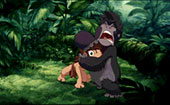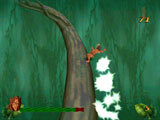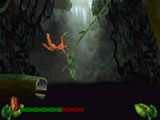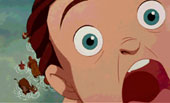 Summer.
The days are hot and long, and it's time for bar-b-ques, camping, and
baseball. Summer doesn't just happen outside, though. It's also
blockbuster movie season, when theaters screen entertainment that's
typically a little lighter in content and more technically dazzling than
the award-oriented films shown in the colder, darker, shorter days of fall
and winter. Accordingly, summer big-screen fun has come to belong to
Disney, which releases an animated feature every year to coincide with the
conditions that make it easy to spend an afternoon in an air conditioned
movie house, often time and time again to see the same feature over and
over.
Summer.
The days are hot and long, and it's time for bar-b-ques, camping, and
baseball. Summer doesn't just happen outside, though. It's also
blockbuster movie season, when theaters screen entertainment that's
typically a little lighter in content and more technically dazzling than
the award-oriented films shown in the colder, darker, shorter days of fall
and winter. Accordingly, summer big-screen fun has come to belong to
Disney, which releases an animated feature every year to coincide with the
conditions that make it easy to spend an afternoon in an air conditioned
movie house, often time and time again to see the same feature over and
over.
 If you've
spent any time near fast-food franchises or a department store, then you
know from all the merchandise that this year's offering from Disney is
"Tarzan," the beautifully rendered retelling of Edgar Rice
Burrough's classic about the Victorian nobleman raised by apes. True to
Disney formula, this movie pushes the limits of 2D media in ways that are
stunning even for Disney. In the last few big Disney movies--from
"Beauty and the Beast," to "The Lion King," and "Mulan"--audiences
where treated to amazing computerized visual articulations of movement on
a grand scale--marches, stampedes and battles--usually rendered from a
privileged, 3/4 perspective. Viewers gazed upon the action from above and
were awed by the spectacle of thousands, indeed millions, of intricate
elements existing in space and time as a single entity. In
"Tarzan," Disney has shifted the audience's focus from massive
panoramas and breathtaking vistas to a dense, compact jungle environment.
While this lush, redolent world serves as the complimentary arena for the
dynamic forces that are Tarzan, it is not a static realm. Indeed, every
leaf and vine seems to course with chlorophyll and sap, conveying the
sense that despite their lack of motion, every tree and root in this film
is just as alive as any stampeding gazelle in "The Lion King,"
just as determined as any marching clansman in "Mulan," and just
as delicately rendered as the individual crystals on the glorious
chandelier in "Beauty and the Beast."
If you've
spent any time near fast-food franchises or a department store, then you
know from all the merchandise that this year's offering from Disney is
"Tarzan," the beautifully rendered retelling of Edgar Rice
Burrough's classic about the Victorian nobleman raised by apes. True to
Disney formula, this movie pushes the limits of 2D media in ways that are
stunning even for Disney. In the last few big Disney movies--from
"Beauty and the Beast," to "The Lion King," and "Mulan"--audiences
where treated to amazing computerized visual articulations of movement on
a grand scale--marches, stampedes and battles--usually rendered from a
privileged, 3/4 perspective. Viewers gazed upon the action from above and
were awed by the spectacle of thousands, indeed millions, of intricate
elements existing in space and time as a single entity. In
"Tarzan," Disney has shifted the audience's focus from massive
panoramas and breathtaking vistas to a dense, compact jungle environment.
While this lush, redolent world serves as the complimentary arena for the
dynamic forces that are Tarzan, it is not a static realm. Indeed, every
leaf and vine seems to course with chlorophyll and sap, conveying the
sense that despite their lack of motion, every tree and root in this film
is just as alive as any stampeding gazelle in "The Lion King,"
just as determined as any marching clansman in "Mulan," and just
as delicately rendered as the individual crystals on the glorious
chandelier in "Beauty and the Beast."
 Of course,
Tarzan himself is the genius of this paradise, and as such, he moves
through it with a kinetic ease that is dazzling. The ways Disney Studios
have devised to illustrate the idea that Tarzan belongs to this edenic
world, that he is a "natural" among the trees and denizens of
the jungle is astonishing. As often as the Ape Man appears to jump off the
screen, the audience finds itself in the treetops, surfing branches and
swinging from vines. It is this blurring of the line between passive
observation and active participation by means of visual artistry that
Disney Interactive further develops in "Disney's Tarzan Action
Game."
Of course,
Tarzan himself is the genius of this paradise, and as such, he moves
through it with a kinetic ease that is dazzling. The ways Disney Studios
have devised to illustrate the idea that Tarzan belongs to this edenic
world, that he is a "natural" among the trees and denizens of
the jungle is astonishing. As often as the Ape Man appears to jump off the
screen, the audience finds itself in the treetops, surfing branches and
swinging from vines. It is this blurring of the line between passive
observation and active participation by means of visual artistry that
Disney Interactive further develops in "Disney's Tarzan Action
Game."
First of all, it would seem enough of a challenge for Disney
Interactive to have successfully created a 3D action game that at once
captured and extended the already beautifully wrought 2D world of the
"Tarzan" movie. This task would seem doubly difficult
considering how convincingly Disney had already pushed the limits of 2D in
the movie itself. Disney Interactive, though, in the spirit of innovation
that produced the animated feature, has done something truly remarkable:
they have created a 3D side-scrolling adventure that doesn't really scroll
from the side at all. In "Disney's Tarzan Adventure Game,"
players maneuver Tarzan--first as a boy and then a man--who runs, leaps
and swings through a panoramic environment that scrolls heighth, breadth, depth and
width.

We chatted with Dan Winters of Disney Interactive about
the implementation of a 3D graphical environment within the structure of a
feature produced in 2D and discovered that the engine used in Tarzan is
produced by Eurocom and is a modified version of the same engine they
designed for the Hercules action game. It's interesting to note that
the full range movement in Hercules was rendered in 2D and changed to full
3D in Tarzan. The additional efforts were implemented with the
intent of total immersion within the jungle environment that Tarzan
inhabits and the results are nothing short of spectacular. We found
ourselves marveling time and again at elements as diverse as tree
trunks, waterfalls, and all manner of fauna.

Among the typically wondrous graphical treats are some
astounding transitions, one of which is partially shown above. As
young Tarzan you're scrolling along, encountering numerous game play elements,
and you make what appears to be a rather
ordinary leap from one ledge to another when suddenly you're gracefully
arcing through the air, sailing ever downward until you cut Louganis-like
through the water's surface. It is simply breathtaking.
Another scene implementing a very slick transition comes later when
you play as Jane being pursued by a gang of baboons. At one point in
the level Tarzan swoops out of the trees, plucks Jane up, and performs a
little tree-surfing action. What's happened is that the player has
transitioned from Jane to Tarzan, smoothly, seamlessly, and elegantly
within a single level.
 Although
Tarzan shoots for an audience from eight years upward, apparently there's
no clear top end to the target audience. For instance, Tarzan is
designed to run on high-end machines with 3D accelerated video cards,
somewhat unusual if the game was limited to younger audiences. Game play
fluctuates between familiar side-scrolling and Crash
Bandicoot-like chases and the levels are linked by digitized clips direct
from the feature film. Camera triggers within the game exert great
fluidity combined with artful control over the variety of perspectives
players encounter in the game. These elements begin to orchestrate a
sophisticated approach to gaming that simply screams to interact with an
audience beyond pre-teens.
Although
Tarzan shoots for an audience from eight years upward, apparently there's
no clear top end to the target audience. For instance, Tarzan is
designed to run on high-end machines with 3D accelerated video cards,
somewhat unusual if the game was limited to younger audiences. Game play
fluctuates between familiar side-scrolling and Crash
Bandicoot-like chases and the levels are linked by digitized clips direct
from the feature film. Camera triggers within the game exert great
fluidity combined with artful control over the variety of perspectives
players encounter in the game. These elements begin to orchestrate a
sophisticated approach to gaming that simply screams to interact with an
audience beyond pre-teens.
 For
all the considerable accomplishments achieved by Eurocom and Disney
Interactive, there remain some shortcomings to the game. The 13
levels play surprisingly quickly, and the two levels that incorporate
"the chase" are probably too similar to Crash Bandicoot; a bit
less fun and a bit more predictable than the other levels. There is
no multi-player component to the game. Finally, while the voices of
both young and adult Tarzan, and Clayton are those of the feature actors,
the voices of Terk and Jane are too often unconvincing imitations of
Rosie O'Donnell and Minnie Driver.
For
all the considerable accomplishments achieved by Eurocom and Disney
Interactive, there remain some shortcomings to the game. The 13
levels play surprisingly quickly, and the two levels that incorporate
"the chase" are probably too similar to Crash Bandicoot; a bit
less fun and a bit more predictable than the other levels. There is
no multi-player component to the game. Finally, while the voices of
both young and adult Tarzan, and Clayton are those of the feature actors,
the voices of Terk and Jane are too often unconvincing imitations of
Rosie O'Donnell and Minnie Driver.
 The
biggest disappointment of the Tarzan Action Game is how quickly it passes
because it really whets our appetite and makes us hunger for more.
The presence of many revolutionary game play elements effectively breathe
new life into the tried-and-true side-scroller genre and take it to
another level. Through thoughtful and innovative narrative and
aesthetic pacing, Disney feature films have often appealed to young and
old alike; with the Tarzan Action Game, Disney Interactive looks to pursue
the same goals with interactive entertainment. Despite its brevity,
we are inclined to borrow a line from another summer blockbuster to
summarize our review: "the force is strong with this one."
The
biggest disappointment of the Tarzan Action Game is how quickly it passes
because it really whets our appetite and makes us hunger for more.
The presence of many revolutionary game play elements effectively breathe
new life into the tried-and-true side-scroller genre and take it to
another level. Through thoughtful and innovative narrative and
aesthetic pacing, Disney feature films have often appealed to young and
old alike; with the Tarzan Action Game, Disney Interactive looks to pursue
the same goals with interactive entertainment. Despite its brevity,
we are inclined to borrow a line from another summer blockbuster to
summarize our review: "the force is strong with this one."
--Greg
Matthews & Al WIldey

 Summer.
The days are hot and long, and it's time for bar-b-ques, camping, and
baseball. Summer doesn't just happen outside, though. It's also
blockbuster movie season, when theaters screen entertainment that's
typically a little lighter in content and more technically dazzling than
the award-oriented films shown in the colder, darker, shorter days of fall
and winter. Accordingly, summer big-screen fun has come to belong to
Disney, which releases an animated feature every year to coincide with the
conditions that make it easy to spend an afternoon in an air conditioned
movie house, often time and time again to see the same feature over and
over.
Summer.
The days are hot and long, and it's time for bar-b-ques, camping, and
baseball. Summer doesn't just happen outside, though. It's also
blockbuster movie season, when theaters screen entertainment that's
typically a little lighter in content and more technically dazzling than
the award-oriented films shown in the colder, darker, shorter days of fall
and winter. Accordingly, summer big-screen fun has come to belong to
Disney, which releases an animated feature every year to coincide with the
conditions that make it easy to spend an afternoon in an air conditioned
movie house, often time and time again to see the same feature over and
over.